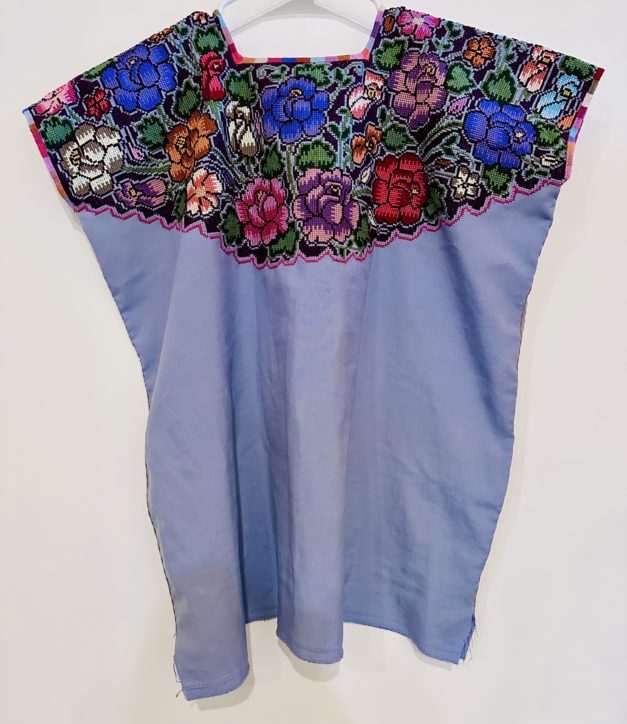Gold filigree earrings are a favorite of traditional indigenous women in villages throughout Oaxaca, Mexico. Mexican gold filigree jewelry, usually 10k or 12k, is gifted at life cycle events and is an important part of engagement and marriage traditions. Antique pieces are usually more costly because of the workmanship.
Filigrana, the art of working gold threads or coils into intricate designs, was brought to Mexico by the Spanish after the conquest. The Spanish learned the technique from the Moors. Master goldsmiths taught local craftsmen and the skill became a family trade handed down through the generations. Today, there are a few master craftsmen working in gold, but because of the cost many visitors to Oaxaca choose filigree worked in sterling silver.
One such filigree craftsman is Mario Perez, who shares a shop with famed woodcarver Jacobo Angeles on Macedonio Alcala. Step inside to see how silver becomes bows from which dangle gemstones and colored glass, curlicues, birds, flowers and angels. The designs are intricate and beautifully executed. Mario makes earrings, pendants, rings, and complete necklaces.
Be careful — cuidado — if you are shopping price, beware that there are knock-offs that are imported from China. Yes, indeedy.
One of my favorite places to explore and window shop is the Casa de Empeño Monte Piedad. This is a bonafide government owned/regulated pawn shop located at the corner of Macedonio Alcala and Morelos, and one of the biggest. Doors close between 2:00 pm and 3:00 pm. At the corner is the Caja, the payment center. Walk two doors down on Morelos (toward Garcia Virgil) to see the display of goodies for sale — some upwards of $10,000 USD.
Everything is priced by weight. If you are lucky, you might find an antique pair of gold filigrana earrings (like I did the other day) for well under $80 USD. One of the pearls was missing but all the parts worked beautifully. I walked to a small family operated jewelry shop a few blocks away from the Zocalo, asked if they did repairs, and twenty minutes later my earrings were fixed — better than new!. Materials and labor: $8 USD.
The pawn shops are filled with merchandise now. I don’t know why. Maybe more people are out of work, or what grandmother liked the granddaughters don’t, or the Guelaguetza tourist season was underwhelming and families need cash. There are other priorities besides jewelry. Many Casa de Empeños are located throughout the city, especially near in the 20 de Noviembre market. Keep your eyes open. You may not need to buy retail if you admire the old artistry.
P.S. This is the rainy season and it is dry, dry, dry. No rain for weeks. The corn is yellowing and some fields are dead. Today, my next door neighbor irrigated his field. How? Water from a well or flowing from the mountain reservoir. The water gushed down trenches dug yesterday. This coming season will likely bring scarcity and high prices for maize. When food costs soar, people will sell what is not essential. Abundance in the pawn shops. Join me in the prayer for rain. It is painful to watch the fields shriveling and giving up their promise of food.











































Cultural and Social Tourism Focus for Guanajuato Delegation to Oaxaca
Tourism and economic development officials from Guanajuato, Mexico, came to Oaxaca to meet and talk with artisans, artists, microfinanciers, arts educators, and entrepreneurs. I helped them arrange their itinerary and hosted them during their stay. The group plans to develop social/cultural tourism educational projects for their state with hopes to reduce the talent drain due to out-migration and keep people employed locally in sustainable work that can ensure cultural continuity. What we do at Oaxaca Cultural Navigator is one model for possible program development.
Because Guanajuato is a silver mining area, I took the group to meet with silversmiths Brigitte Huet and Ivan Campant who work in the lost wax casting technique — a process used by the ancient Mixtecs and Mayans. We spent the day in the studio learning about the intricacies and complexities of this jewelry making technique.
Brigitte and Ivan translate their bold designs into carved into wax. They then make molds, melt the 925 sterling silver, pour the molten silver into the molds, and disperse the metal into the cast design using the ancient sling method. Believe me, this is not easy. You need to know chemistry and have a steady hand!
The results are stunning earrings, necklaces, pendants, rings and bracelets using designs adapted from Mexican codices and temple carvings. We gained a greater appreciation for this type of work, since it is detailed, technical, and requires many steps and a lot of patience.
The multi-step process includes putting your design onto the wax, carving the wax, making a master, making a mold, injecting it with wax, using the wax design to fit into the plaster encased in the container, pouring the molten silver into the plaster, using the sling to disperse the silver, cooling the piece, removing it, cleaning it, oxidizing it, polishing it, and then using classical jewelry making techniques (like using the laminator) to make a finished piece of jewelry.
Brigitte and Ivan teach 3-day jewelry making workshops here in Oaxaca. You can contact Norma Hawthorne to schedule your own personal workshop — two person minimum!
Like this:
2 Comments
Posted in Cultural Commentary, Jewelry, Oaxaca Mexico art and culture, Photography, Travel & Tourism
Tagged blogsherpa, class, course, jewelry, Mexico, Oaxaca, silver